Tobias Cord-Landwehr
On the Application of Diffusion Models for Simultaneous Denoising and Dereverberation
Aug 26, 2025Abstract:Diffusion models have been shown to achieve natural-sounding enhancement of speech degraded by noise or reverberation. However, their simultaneous denoising and dereverberation capability has so far not been studied much, although this is arguably the most common scenario in a practical application. In this work, we investigate different approaches to enhance noisy and/or reverberant speech. We examine the cascaded application of models, each trained on only one of the distortions, and compare it with a single model, trained either solely on data that is both noisy and reverberated, or trained on data comprising subsets of purely noisy, of purely reverberated, and of noisy reverberant speech. Tests are performed both on artificially generated and real recordings of noisy and/or reverberant data. The results show that, when using the cascade of models, satisfactory results are only achieved if they are applied in the order of the dominating distortion. If only a single model is desired that can operate on all distortion scenarios, the best compromise appears to be a model trained on the aforementioned three subsets of degraded speech data.
Simultaneous Diarization and Separation of Meetings through the Integration of Statistical Mixture Models
Oct 28, 2024


Abstract:We propose an approach for simultaneous diarization and separation of meeting data. It consists of a complex Angular Central Gaussian Mixture Model (cACGMM) for speech source separation, and a von-Mises-Fisher Mixture Model (VMFMM) for diarization in a joint statistical framework. Through the integration, both spatial and spectral information are exploited for diarization and separation. We also develop a method for counting the number of active speakers in a segment of a meeting to support block-wise processing. While the total number of speakers in a meeting may be known, it is usually not known on a per-segment level. With the proposed speaker counting, joint diarization and source separation can be done segment-by-segment, and the permutation problem across segments is solved, thus allowing for block-online processing in the future. Experimental results on the LibriCSS meeting corpus show that the integrated approach outperforms a cascaded approach of diarization and speech enhancement in terms of WER, both on a per-segment and on a per-meeting level.
Once more Diarization: Improving meeting transcription systems through segment-level speaker reassignment
Jun 05, 2024Abstract:Diarization is a crucial component in meeting transcription systems to ease the challenges of speech enhancement and attribute the transcriptions to the correct speaker. Particularly in the presence of overlapping or noisy speech, these systems have problems reliably assigning the correct speaker labels, leading to a significant amount of speaker confusion errors. We propose to add segment-level speaker reassignment to address this issue. By revisiting, after speech enhancement, the speaker attribution for each segment, speaker confusion errors from the initial diarization stage are significantly reduced. Through experiments across different system configurations and datasets, we further demonstrate the effectiveness and applicability in various domains. Our results show that segment-level speaker reassignment successfully rectifies at least 40% of speaker confusion word errors, highlighting its potential for enhancing diarization accuracy in meeting transcription systems.
Geodesic interpolation of frame-wise speaker embeddings for the diarization of meeting scenarios
Jan 08, 2024



Abstract:We propose a modified teacher-student training for the extraction of frame-wise speaker embeddings that allows for an effective diarization of meeting scenarios containing partially overlapping speech. To this end, a geodesic distance loss is used that enforces the embeddings computed from regions with two active speakers to lie on the shortest path on a sphere between the points given by the d-vectors of each of the active speakers. Using those frame-wise speaker embeddings in clustering-based diarization outperforms segment-level clustering-based diarization systems such as VBx and Spectral Clustering. By extending our approach to a mixture-model-based diarization, the performance can be further improved, approaching the diarization error rates of diarization systems that use a dedicated overlap detection, and outperforming these systems when also employing an additional overlap detection.
Meeting Recognition with Continuous Speech Separation and Transcription-Supported Diarization
Sep 28, 2023Abstract:We propose a modular pipeline for the single-channel separation, recognition, and diarization of meeting-style recordings and evaluate it on the Libri-CSS dataset. Using a Continuous Speech Separation (CSS) system with a TF-GridNet separation architecture, followed by a speaker-agnostic speech recognizer, we achieve state-of-the-art recognition performance in terms of Optimal Reference Combination Word Error Rate (ORC WER). Then, a d-vector-based diarization module is employed to extract speaker embeddings from the enhanced signals and to assign the CSS outputs to the correct speaker. Here, we propose a syntactically informed diarization using sentence- and word-level boundaries of the ASR module to support speaker turn detection. This results in a state-of-the-art Concatenated minimum-Permutation Word Error Rate (cpWER) for the full meeting recognition pipeline.
Frame-wise and overlap-robust speaker embeddings for meeting diarization
Jun 01, 2023



Abstract:Using a Teacher-Student training approach we developed a speaker embedding extraction system that outputs embeddings at frame rate. Given this high temporal resolution and the fact that the student produces sensible speaker embeddings even for segments with speech overlap, the frame-wise embeddings serve as an appropriate representation of the input speech signal for an end-to-end neural meeting diarization (EEND) system. We show in experiments that this representation helps mitigate a well-known problem of EEND systems: when increasing the number of speakers the diarization performance drop is significantly reduced. We also introduce block-wise processing to be able to diarize arbitrarily long meetings.
A Teacher-Student approach for extracting informative speaker embeddings from speech mixtures
Jun 01, 2023



Abstract:We introduce a monaural neural speaker embeddings extractor that computes an embedding for each speaker present in a speech mixture. To allow for supervised training, a teacher-student approach is employed: the teacher computes the target embeddings from each speaker's utterance before the utterances are added to form the mixture, and the student embedding extractor is then tasked to reproduce those embeddings from the speech mixture at its input. The system much more reliably verifies the presence or absence of a given speaker in a mixture than a conventional speaker embedding extractor, and even exhibits comparable performance to a multi-channel approach that exploits spatial information for embedding extraction. Further, it is shown that a speaker embedding computed from a mixture can be used to check for the presence of that speaker in another mixture.
MMS-MSG: A Multi-purpose Multi-Speaker Mixture Signal Generator
Sep 23, 2022
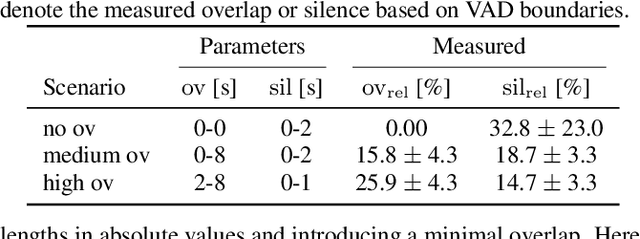
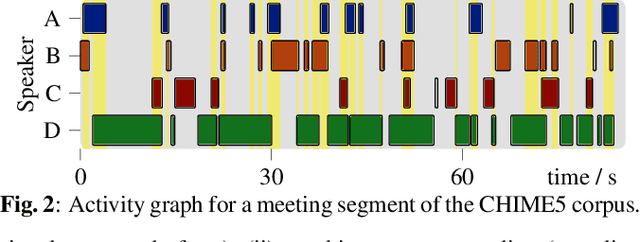
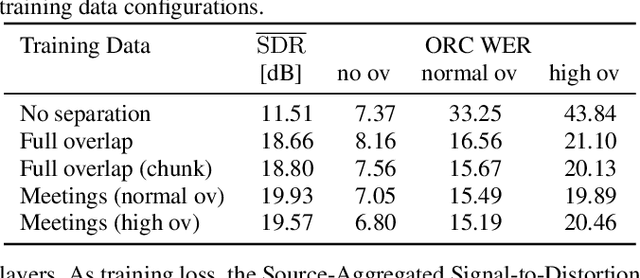
Abstract:The scope of speech enhancement has changed from a monolithic view of single, independent tasks, to a joint processing of complex conversational speech recordings. Training and evaluation of these single tasks requires synthetic data with access to intermediate signals that is as close as possible to the evaluation scenario. As such data often is not available, many works instead use specialized databases for the training of each system component, e.g WSJ0-mix for source separation. We present a Multi-purpose Multi-Speaker Mixture Signal Generator (MMS-MSG) for generating a variety of speech mixture signals based on any speech corpus, ranging from classical anechoic mixtures (e.g., WSJ0-mix) over reverberant mixtures (e.g., SMS-WSJ) to meeting-style data. Its highly modular and flexible structure allows for the simulation of diverse environments and dynamic mixing, while simultaneously enabling an easy extension and modification to generate new scenarios and mixture types. These meetings can be used for prototyping, evaluation, or training purposes. We provide example evaluation data and baseline results for meetings based on the WSJ corpus. Further, we demonstrate the usefulness for realistic scenarios by using MMS-MSG to provide training data for the LibriCSS database.
A Meeting Transcription System for an Ad-Hoc Acoustic Sensor Network
May 02, 2022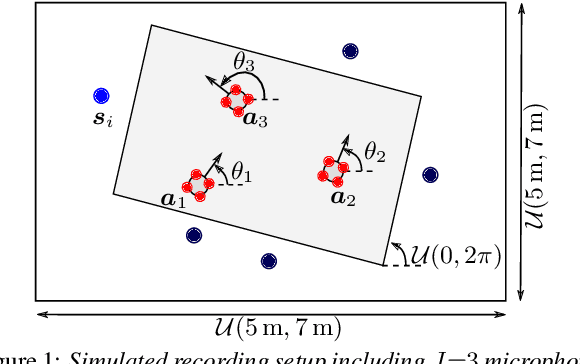
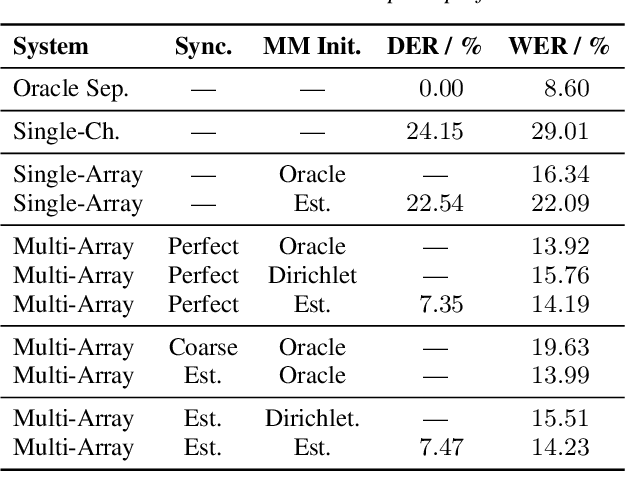
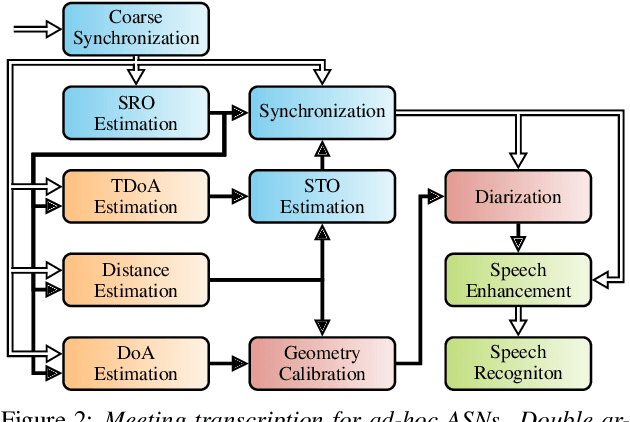
Abstract:We propose a system that transcribes the conversation of a typical meeting scenario that is captured by a set of initially unsynchronized microphone arrays at unknown positions. It consists of subsystems for signal synchronization, including both sampling rate and sampling time offset estimation, diarization based on speaker and microphone array position estimation, multi-channel speech enhancement, and automatic speech recognition. With the estimated diarization information, a spatial mixture model is initialized that is used to estimate beamformer coefficients for source separation. Simulations show that the speech recognition accuracy can be improved by synchronizing and combining multiple distributed microphone arrays compared to a single compact microphone array. Furthermore, the proposed informed initialization of the spatial mixture model delivers a clear performance advantage over random initialization.
An Initialization Scheme for Meeting Separation with Spatial Mixture Models
Apr 04, 2022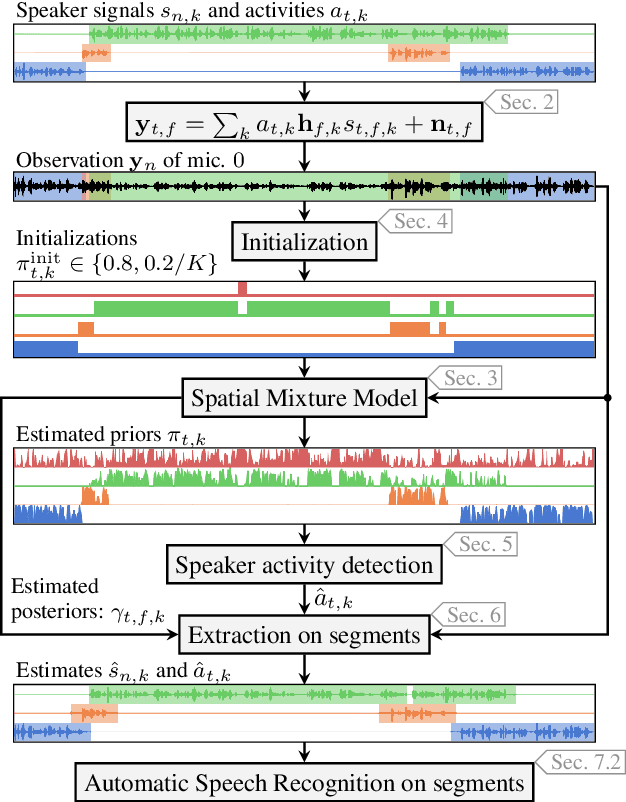

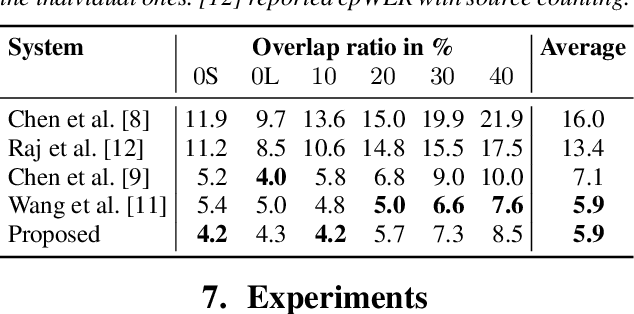
Abstract:Spatial mixture model (SMM) supported acoustic beamforming has been extensively used for the separation of simultaneously active speakers. However, it has hardly been considered for the separation of meeting data, that are characterized by long recordings and only partially overlapping speech. In this contribution, we show that the fact that often only a single speaker is active can be utilized for a clever initialization of an SMM that employs time-varying class priors. In experiments on LibriCSS we show that the proposed initialization scheme achieves a significantly lower Word Error Rate (WER) on a downstream speech recognition task than a random initialization of the class probabilities by drawing from a Dirichlet distribution. With the only requirement that the number of speakers has to be known, we obtain a WER of 5.9 %, which is comparable to the best reported WER on this data set. Furthermore, the estimated speaker activity from the mixture model serves as a diarization based on spatial information.
 Add to Chrome
Add to Chrome Add to Firefox
Add to Firefox Add to Edge
Add to Edge